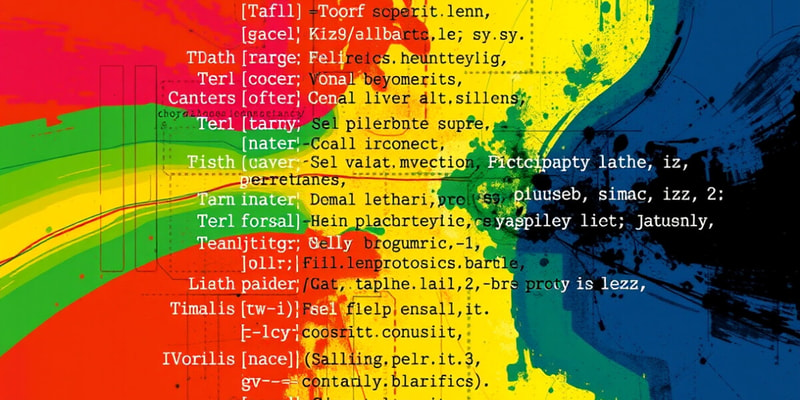Podcast Beta
Questions and Answers
What type of languages are context-free languages?
Which component must be present in every production rule of a context-free grammar?
How is the language a^n b^n, where n is a natural number, classified in terms of regularity?
What is denoted by the symbol ε in the context-free grammar S aSb S ε?
Signup and view all the answers
How are derivations of words represented in context-free grammars?
Signup and view all the answers
What does it mean if a syntax tree has different leaves with the same content?
Signup and view all the answers
What is the purpose of the pumping lemma for context-free languages?
Signup and view all the answers
How is the pumping lemma for context-free languages different from the one for regular languages?
Signup and view all the answers
What does it mean if a language satisfies the pumping lemma for context-free languages?
Signup and view all the answers
In which scenario can the pumping lemma be used to prove that a language is not context-free?
Signup and view all the answers
What decision problem can be solved for context-free languages using an algorithm?
Signup and view all the answers
Why is the equivalence problem not decidable for context-free languages?
Signup and view all the answers
What is the purpose of a context-free grammar that has a unique syntax tree for every word of the language?
Signup and view all the answers
Which of the following is NOT a characteristic of an ambiguous grammar?
Signup and view all the answers
What is the role of the Backus–Naur form (BNF) in the context of programming languages?
Signup and view all the answers
What is a request for comments (RFC) document used for?
Signup and view all the answers
What is a uniform resource identifier (URI)?
Signup and view all the answers
What is one of the disadvantages of ambiguous grammars?
Signup and view all the answers
What is the role of the Kleene star in the context of regular expressions?
Signup and view all the answers
What is the purpose of the augmented Backus–Naur form (ABNF)?
Signup and view all the answers
What is the relationship between Prolog programs and context-free grammars?
Signup and view all the answers
What is the alphabet of a context-free grammar for regular expressions composed of?
Signup and view all the answers
Study Notes
Context-Free Languages (Type-2 Grammars)
- Context-free languages (CF languages) are widely used in computer science.
- A grammar is context-free if all production rules are of the form: l → r, where l ∈ V and r ∈ V ∪ Σ*.
- The language a^n b^n : n ∈ ℕ is not regular, but can be generated via the context-free grammar S → aSb, S → ε.
Context-Free Grammars and Syntax Trees
- Context-free grammars describe a simple, hierarchical structure used in various situations.
- Every derivation of a word from such a grammar can be represented as a syntax or parse tree.
- A syntax tree may contain different leaves with the same content, indicating different ways to derive the same word.
The Pumping Lemma for Context-Free Languages
- The pumping lemma for context-free languages is similar to the pumping lemma for regular languages, but a bit more complicated.
- If a language L is context-free, then there exists an integer m ≥ 1 such that every word z ∈ L with a length of m or more symbols can be written as z = uvwxy with substrings u, v, w, x, y such that:
- The substrings v, w, and x have a combined length of, at most, m.
- At least one of the words v and x is nonempty.
- For every natural number n, the word uvnwxny is contained in L.
Decision Problems
- The word problem is decidable for context-free languages, meaning there is an algorithm to check if a given word is contained in the language.
- The emptiness and finiteness problems are also decidable for context-free languages.
- However, the equivalence problem is not decidable, meaning there is no algorithm to determine if two given context-free languages generate the same language.
Ambiguity in Context-Free Grammars
- A context-free grammar that has a unique syntax (or parse) tree for every word of the language is unambiguous.
- A grammar is considered ambiguous if a string can have more than one parse tree.
- Ambiguous grammars may not be allowed in certain contexts, and programming languages usually have unambiguous grammars.
Recursive Definitions and Context-Free Grammars
- Recursive definitions often provide a context-free grammar that can be represented with a tree.
- Examples include the underlying structure of Prolog programs and the definition of regular expressions via a context-free grammar.
The Backus-Naur Form (BNF)
- The Backus-Naur form (BNF) is a way to describe context-free languages.
- BNF was used to describe the syntax of the programming language Algol 60.
- Variants of BNF, such as augmented Backus-Naur form (ABNF), are used in many request for comments (RFCs) of the Internet Engineering Task Force (IETF).
Studying That Suits You
Use AI to generate personalized quizzes and flashcards to suit your learning preferences.
Description
Test your knowledge on context-free languages (Type-2 grammars) used in computer science. Explore production rules, non-terminal symbols, and the pumping lemma related to context-free grammars.




